Withington Onwards Travel Award Winner 2011
Chloe Honeyborne was awarded the 2011 Withington Onwards (formerly Senior Club) Travel Award, and sent us the following report of her trip to Namibia.
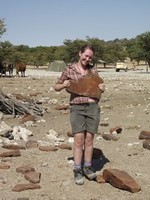 I spent a month volunteering with the charity EHRA(Elephant Human Relations Aid) in the region of Damaraland in Northern Namibian this September.
I spent a month volunteering with the charity EHRA(Elephant Human Relations Aid) in the region of Damaraland in Northern Namibian this September.
EHRA is a not-for-profit organisation which aims to protect and create harmonious relationships between local subsistence farmers and the resident herds of desert elephants. Conflict usually occurs over water resources, the elephants naturally seek out water supplies and often cause damage to water pumps, windmills and buildings as they try to access the water. The subsistence farmers see shooting the elephants as the easiest solution, but this led to mass poaching in the 1970s where the desert elephant populations were hugely depleted. EHRA works with local communities and the Namibian government in order to protect villages from being damaged by the elephants and to help conservation and the development of tourism.
I started my month with EHRA working on a building project in the small town of Okotojoto. Okotojoto is quite a politically tense area because about eighteen months ago a few farmers in the region were responsible for shooting several bulls, mainly because many locals are terrified of the elephants and feel very concerned to protect their modest livelihoods. In the week I spent there we were building a wall around the communal water pump to protect it from destruction by the elephants. The previous wall was poorly built and without proper protection the water supply was easily available to the elephants, a situation which can quickly escalate to scenes of violence if a herd were to drink from the town's supply. The work was arduous and pretty intense since we shovelled sand and collected rocks from nearby and mixed cement by hand. However, everyone in the volunteer team was enthusiastic about the work and we quickly became skilled at choosing and carrying the best rocks, setting foundations and making the wall as sturdy as possible.
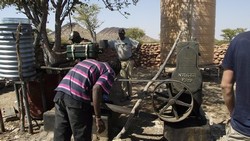 The week was more challenging and physically demanding than I had anticipated but it was fantastic to have a real input into the work which EHRA does which could in no way be sustained without the volunteers. Local people want to be paid and fed for their time and the villagers see shooting elephants as a preferential solution to the problem rather than actually protecting their water and building dams elsewhere so that elephants do not continue to prey on their water sources. We camped a few metres away from the building site without tents, showers or a real toilet which really made me appreciate the way of life of local people who lived in similar conditions permanently. Every day we managed to get covered in cement and sand and were using the cattle troughs for a quick splash of cleanliness. There were a couple of leaders with us – Hendrick Munembome and Betsy Fox who were working on the PEACE(People and Elephants Amicably Co-Existing) project which involved talking to local people and trying to teach them how to protect themselves from the elephants and in what ways they could benefit from their presence there. Simple things like building houses away from water supplies and setting up bee hives which deter the herds can make a huge difference to local communities. EHRA is also working to set up a campsite in the Okotojoto area in order to maximise the potential gains from tourism and benefit from the close proximity of elephant herds to the area.
The week was more challenging and physically demanding than I had anticipated but it was fantastic to have a real input into the work which EHRA does which could in no way be sustained without the volunteers. Local people want to be paid and fed for their time and the villagers see shooting elephants as a preferential solution to the problem rather than actually protecting their water and building dams elsewhere so that elephants do not continue to prey on their water sources. We camped a few metres away from the building site without tents, showers or a real toilet which really made me appreciate the way of life of local people who lived in similar conditions permanently. Every day we managed to get covered in cement and sand and were using the cattle troughs for a quick splash of cleanliness. There were a couple of leaders with us – Hendrick Munembome and Betsy Fox who were working on the PEACE(People and Elephants Amicably Co-Existing) project which involved talking to local people and trying to teach them how to protect themselves from the elephants and in what ways they could benefit from their presence there. Simple things like building houses away from water supplies and setting up bee hives which deter the herds can make a huge difference to local communities. EHRA is also working to set up a campsite in the Okotojoto area in order to maximise the potential gains from tourism and benefit from the close proximity of elephant herds to the area.
After an intensive building week our team of volunteers headed to the EHRA base camp by the Ugab river to replenish supplies and be briefed on our work for the next week of Patrol. As well as addressing the relationship between local communities and elephants on the ground, EHRA's project is also focused on conservation and protection of the herds, a key element of which being Elephant tracking so that the numbers, behaviour and movements of the herds can be monitored. This is beneficial in several ways, primarily for ascertaining which areas are most under threat from elephant movement, and thus where EHRA should prioritise in terms of building walls and also to monitor the numbers of elephants.
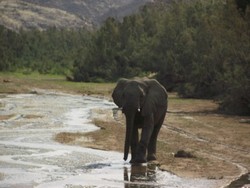 In my first patrol week we set out to find the herds ‘Ugab's Small', ‘G6' and ‘Mamma Afrika' which EHRA had not seen for a few months, the process of finding the elephants is pretty difficult, our trackers were able to study tracks and address the direction and timing of Elephant movements but we relied too on word of mouth from local people about when they had seen elephants passing. After a full day of following tracks we couldn't find the elephants and set up camp in the dry riverbed-however at about 10pm, when the fire was burning out we heard the tell-tale breaking of twigs and slow rumbling noises and soon realised that we were hot on the tracks of the herds we had been following. We quietly alerted everyone to the situation and we all climbed onto the land cruiser as we saw the silhouettes of elephants moving amongst the trees. It was the most amazing experience to have the elephants so close and we waited up until about 3am whilst the herd ‘Mamma Africa' passed through the riverbed, grazing on the surrounding vegetation and moving on to find water.
In my first patrol week we set out to find the herds ‘Ugab's Small', ‘G6' and ‘Mamma Afrika' which EHRA had not seen for a few months, the process of finding the elephants is pretty difficult, our trackers were able to study tracks and address the direction and timing of Elephant movements but we relied too on word of mouth from local people about when they had seen elephants passing. After a full day of following tracks we couldn't find the elephants and set up camp in the dry riverbed-however at about 10pm, when the fire was burning out we heard the tell-tale breaking of twigs and slow rumbling noises and soon realised that we were hot on the tracks of the herds we had been following. We quietly alerted everyone to the situation and we all climbed onto the land cruiser as we saw the silhouettes of elephants moving amongst the trees. It was the most amazing experience to have the elephants so close and we waited up until about 3am whilst the herd ‘Mamma Africa' passed through the riverbed, grazing on the surrounding vegetation and moving on to find water.
In the morning camp was covered in tracks and we were able to set off early with a clear idea of where the herds were. We soon found ‘Mamma Afrika' and began to document the condition of the elephants and identify which ones we could see. However, our trackers were very surprised to see several unidentified elephants that were new to the area and hadn't previously been documented. We soon set about photographing these elephants and noting any distinguishable features for future identification. We noticed that the largest elephant had several bullet holes in one ear and a broken tusk and were later told that herds sometimes roam down to Damaraland from Etosha in the North. We followed the herd for several days noting their behaviour and movements and plotting where they were headed next, pleased that we had found a new herd.
On the last day of our patrol we were heading back to the base camp for supplies and we came across a well which was surrounded by a large goat farm, in the distance we could see the herds moving towards the well and soon realised that three herds were congregating there from all directions. About 25 elephants in total walked up to the well and started to drink from it, we were amazed by the sheer number of elephants and saw several locals looking out at the scene feeling quite anxious and intimidated. Within minutes we saw the farmer mount his horse and he began to charge towards the well; we tried to wave and tell him to stop and luckily he did so in just about enough time, had he galloped ahead he would easily have been outnumbered and overrun by the herds.
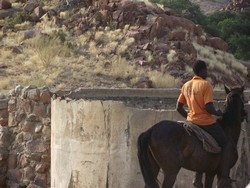 The scene was quite shocking, but it really showed me how important the work that EHRA does is-there is a great deal of ignorance about elephant behaviour amongst local people and this ignorance can lead to higher levels of elephant aggression and trauma when herds are shot at and could also lead to injury or fatalities amongst local people. At the end of patrol week we set off on a four hour drive to the coastal town of Swakopmund to say farewell to some volunteers and pick up volunteers who would be working with us for the next two weeks in the desert. Moving from the heat of the desert to the coastal breeze and enjoying a luxurious hot shower and a trip to a well-stocked supermarket made the weekend a great break after two weeks of volunteering.
The scene was quite shocking, but it really showed me how important the work that EHRA does is-there is a great deal of ignorance about elephant behaviour amongst local people and this ignorance can lead to higher levels of elephant aggression and trauma when herds are shot at and could also lead to injury or fatalities amongst local people. At the end of patrol week we set off on a four hour drive to the coastal town of Swakopmund to say farewell to some volunteers and pick up volunteers who would be working with us for the next two weeks in the desert. Moving from the heat of the desert to the coastal breeze and enjoying a luxurious hot shower and a trip to a well-stocked supermarket made the weekend a great break after two weeks of volunteering.
Two weeks before I left to volunteer with EHRA I was contacted by the charities co-founder, because two people at the last minute had dropped out of their annual fund-raising trek meaning that it would no longer be feasible or safe to trek with the depleted group. Since the 5 day trek fell into the period when I was in Namibia working for EHRA I was asked whether I would be willing to take part in it so that it could still take place (EHRA had struggled last year because the annual trek could not feasibly run). I researched the challenge and found out that it was a very intensive trek across the desert, volcanoes and sand dunes of Namibia completing 140 kilometers on foot in a mere 5 days. Having done no training for the challenge, I was concerned about my ability to take part but felt that it would be a great shame for the trek not to go ahead and that perhaps my Gold DofE award would be training enough.
The annual trek was set up two years ago in order to raise extra money for the charity; since EHRA is a not-for-profit organisation all the money paid by volunteers covers only their food, travel and camping costs and therefore when it comes to bigger financial investments EHRA has no pot of money to fall back on. Two years ago the government advertised a permit to be sold to cull a bull named Vortrekker, however since Vortrekker is the only breeding bull in the Ugab River area, EHRA was really concerned about the concentration of the gene pool and the long-term impact this would have on the health of the elephant population. Despite warning the government that the selling of the permit would seriously harm elephant populations, jeopardise employment in the tourism industry and damage the local economy they warned EHRA that the only way to stop Vortrekker being culled would be for them to buy the permit, at a staggering cost of about £10,000, the amount they claimed would be lost in profits from meat, elephant hair and tusk sales. The 2009 trek successfully raised enough money for the permit and Vortrekker was not culled as the government planned.
The challenge for the 2011 trek was to raise money of the more practical need for EHRA to buy a new vehicle. The two land cruisers owned by EHRA are becoming incredibly unreliable since they weren't actually bought from new but the shells were found abandoned in the desert and were reconstructed when the charity was set up (the four by four is loving called ‘Phoenix' as it was literally raised from its outer shell or ashes).
When I arrived back in Swakopmund we had a quick turnaround in stocking up on supplies and then I met the team of trekkers and we headed out again into the desert. Within minutes of meeting my fellow trekkers, I discovered that last time trek-veteran Hazel had lost 5 toenails on the 140km hike, and I was pretty concerned about what lay ahead. However, despite the difficulty of trekking by foot for several hours every day in the desert, the challenge was incredibly rewarding and an experience which was the icing on the cake of my four weeks with EHRA. We saw the most incredible and diverse landscapes ranging from the jaw-dropping view from Doris Crater to volcanic hills, golden grassland, sand dunes, riverbeds and even slept one night in a cave! The experience was phenomenal and I felt very lucky to be offered the opportunity as part of my time working with the charity. Ironically I appreciated just how important our fundraising was when our car was stranded for a couple of hours in the heat of the day on a treacherous road back to base camp.
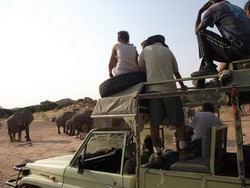 After the trek I returned to the group of volunteers and set off on patrol week. This week we were travelling further North in the desert to find the herds of H1 and H2 which had not been seen by EHRA for quite some time. The herds were more difficult to find because there was a larger area to cover, but after a day and a half of searching we found the herd of H1 and discovered a three month old calf which was quite an amazing sight to behold. Elephants grow continually throughout their lives so seeing the tiny calf next to 50-60 year old cows in the herd was pretty spectacular. While we were monitoring the herd we also noted that one of the cows was pregnant too and we tracked their movements through the desert for a couple of days until we discovered the second herd H2. Seeing first-hand the nature of elephants in the wild was quite astonishing, Elephants have feelings of family ties, hierarchy and community within the herds which is distinctly special amongst the animal kingdom. They communicate using at least 22 different sounds and are quite incredible creatures to monitor.
After the trek I returned to the group of volunteers and set off on patrol week. This week we were travelling further North in the desert to find the herds of H1 and H2 which had not been seen by EHRA for quite some time. The herds were more difficult to find because there was a larger area to cover, but after a day and a half of searching we found the herd of H1 and discovered a three month old calf which was quite an amazing sight to behold. Elephants grow continually throughout their lives so seeing the tiny calf next to 50-60 year old cows in the herd was pretty spectacular. While we were monitoring the herd we also noted that one of the cows was pregnant too and we tracked their movements through the desert for a couple of days until we discovered the second herd H2. Seeing first-hand the nature of elephants in the wild was quite astonishing, Elephants have feelings of family ties, hierarchy and community within the herds which is distinctly special amongst the animal kingdom. They communicate using at least 22 different sounds and are quite incredible creatures to monitor.
At the end of patrol week after gathering all the necessary data we set off early for the journey back to base camp, however we soon realised that the land cruisers were empty on fuel and we didn't have enough to make it back to the nearest town or petrol station. The main problem was that the fuel gage was broken and our spare jerry cans of fuel had been stolen, stranded in the desert we pulled up alongside a nearby road and waited to see if there would be any traffic. Luckily we were able to buy the right type of fuel from a passing jeep and we had just about enough water to keep up morale while we were stranded and we moved on before nightfall. The experience was not one uncommon in the Namibian way of life but really hit home to me how important the fundraising was for the trek and the difficulty that EHRA faces in continuing its work in such harsh conditions. However when we arrived back at base camp triumphantly and were able to cook a braai together round the campfire the difficulties of the day were soon forgotten.
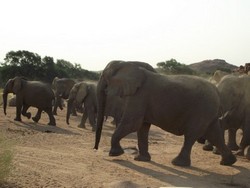 Although I was looking forward to returning to civilisation I was incredibly sad to leave the desert along with my fellow volunteers, the locals who help out on the project and the EHRA staff who brought us together as a community. I was later told that the volunteer project was seen to mirror the makeup of a herd of elephants, we were a group of totally different age, nationalities and cultures and yet brought together regardless as we worked, ate and slept alongside each other. There was nothing quite so spectacular as sleeping under the stars in the desert, waking up to elephant tracks and knowing that the work we were putting in made a real difference to the elephants but more importantly to the protection and development of local communities.
Although I was looking forward to returning to civilisation I was incredibly sad to leave the desert along with my fellow volunteers, the locals who help out on the project and the EHRA staff who brought us together as a community. I was later told that the volunteer project was seen to mirror the makeup of a herd of elephants, we were a group of totally different age, nationalities and cultures and yet brought together regardless as we worked, ate and slept alongside each other. There was nothing quite so spectacular as sleeping under the stars in the desert, waking up to elephant tracks and knowing that the work we were putting in made a real difference to the elephants but more importantly to the protection and development of local communities.
My experience with EHRA was very moving and insightful into an entirely different way of life and I am eager to return to work on the project at a later date if possible. I am still keen to raise more money for EHRA as I have seen how important it is to the project and how much of a difference it can make in Namibia. If you would like to find out more about the volunteer project or would like to choose EHRA as your form's charity this year do not hesitate to get in touch with me. Without EHRA there would almost certainly be no desert elephants in Namibia and no possibility of the development of tourism or the sustaining of cattle and produce due to the importance of elephant dung in the ecosystem. I am incredibly grateful to the Withington Onwards Committee for the Travel Award I received which was really appreciated in my fundraising for the trip.

